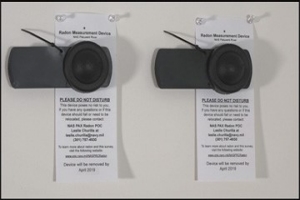Key Things to Remember about the Survey:
-
The devices will be attached to walls, but may hang from ceilings or other structures.
-
They will be in place for one year.
-
Because radon comes from the ground, only lower portions of a selected building will be tested.
-
They pose no health risk and do not contain electronic recording instrumentation of any kind.
-
Please do not disturb the devices. They are extremely sensitive and will give false positive results if tampered with. All positive results will be confirmed with further testing before a final determination of radon levels are made.
Below is an image of the radon measurement devices as they will be placed at NAS Pax River buildings. These devices are extremely sensitive and should not be touched, moved, or placed in close proximity to fans or open windows.

Dual radon measurement devices attached to wall

Should a device fall or need to be temporarily moved, please contact NAS Pax River Radon POC at (301) 757-4930.